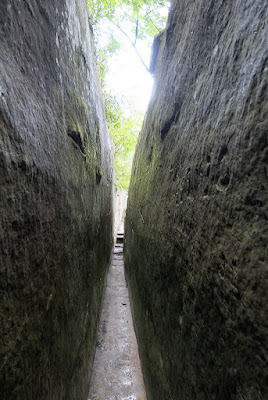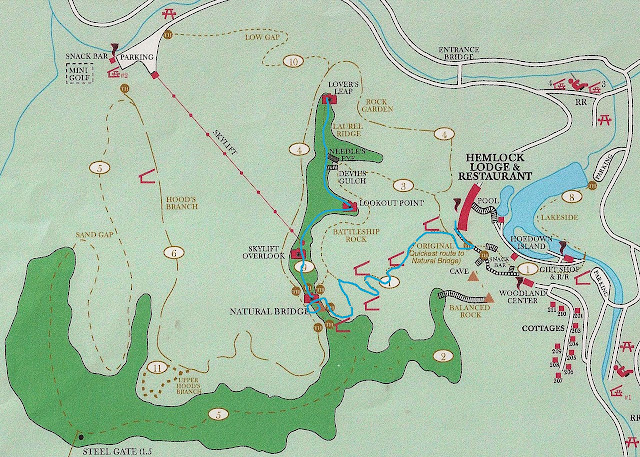 |
| Click on any image to enlarge. |
 |
| Our route is in blue. |
Our next destination, Lookout Point, was the bluff on the far left of the above photo.Zooming in, somebodies were already there.Along the way we crossed the skylift, for those who want to ride to the ridgetop. We saw it unattended, because the staff hadn't ridden up yet.
Looking down to the parking area.On reaching Lookout Point, we stared at the view. The Natural Bridge is at the ridgeline, far right.A closer photo ...Our next phase was to head out to Lover's Leap, and the end of the ridge.Along the way, mountain laurel was wrapping up its blooming season.Another grand view at the Leap. Mists continued to rise.
A closer look at the knob.We began to retrace our steps, and just ten minutes later a scarlet tanager flew in. I've always had a hard time photographing tanagers, as they favor staying high in the trees and flitting about. This one, however, gave me my best-ever scarlet tanager photo.At the skylift two staffers were now in place. Joan and I walked back to the Natural Bridge, and admired the view some more. Another hiker, studying his phone, warned us that "some showers are supposed to arrive in an hour or so." This did not worry us, as we were prepared, having brought along rain jackets and covers for our day packs. Joan and I descended from the bridge to begin taking the lower loop around the ridge, starting with Battleship Rock.Many large blocks have fallen off the ridge. It would be fun to see how this landscape looks when the leaves are down.
 |
| Joan is in the background, right side. |
The Natural Bridge was closer than I expected, a welcome surprise. Joan and I could return to the lodge the way we'd come, or climb to the top of the bridge again, to take in the Balanced Rock route.We were already wet, so why not go on? The stairway and slot pictured earlier in this post were gushing torrents a couple of inches deep. We laughed and climbed up. Once freed of the worry of staying dry, it was fun to watch the waters.
Of course, I wasn't pulling out my camera. Suffice it to say that we saw Balanced Rock, which would have been worth lingering beside at any other time, and returned to our room in the lodge. On the last quarter-mile the rain finally stopped.
Dealing with our dirt-splashed, sodden everything was a herculean task. The lodge rooms were of an earlier generation and on the small side. Hooks? No. Our wet gear was draped over the shower rod, on all the coat hangers, on the backs of chairs, and over the flat screen TV. We were desperate for space. Because we allowed our pants to get wet, the tops of the hiking socks picked up water, and we were in such a monsoon that every square millimeter of the socks and boot interiors were soaked when we got back. The water that ran down the backs of our rain jackets penetrated the day packs, and some items not in plastic baggies were a total loss.
And everything wanted to stay wet. We had no control over the heat or air conditioning beyond setting a temperature, and the fan automatically shut off once that temp was reached. The circulation was pitiful. The lamps had been upgraded to LED bulbs, so our trick of draping socks over hot rising air was thwarted. Joan and I took turns using the hair dryer on suitable items, including the socks.
But we persevered, and, as the night before, had a glass of wine at the bar before dinner. It had been a good day, but we hoped tomorrow, our last day of hiking, would be dryer.
























































